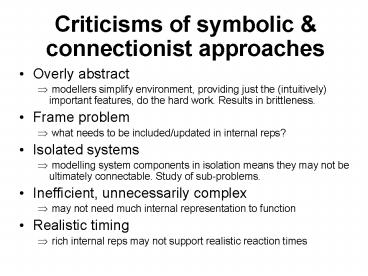Criticisms of symbolic - PowerPoint PPT Presentation
1 / 17
Title:
Criticisms of symbolic
Description:
... and moves toward them; suppresses wander layer. Wander layer: Generates random movement commands ... inhibits wander layer. send path to pathplan. pathplan ... – PowerPoint PPT presentation
Number of Views:51
Avg rating:3.0/5.0
Title: Criticisms of symbolic
1
Criticisms of symbolic connectionist approaches
- Overly abstract
- modellers simplify environment, providing just
the (intuitively) important features, do the hard
work. Results in brittleness. - Frame problem
- what needs to be included/updated in internal
reps? - Isolated systems
- modelling system components in isolation means
they may not be ultimately connectable. Study of
sub-problems. - Inefficient, unnecessarily complex
- may not need much internal representation to
function - Realistic timing
- rich internal reps may not support realistic
reaction times
2
Brooks approach to AI
- Basis for developing true intelligence
- mobility
- acute vision (sensory capabilities)
- ability to carry out survival related tasks
- Bottom-up
- Start small
- Incrementally build up capabilities of
intelligent systems that interact with the real
world. - At each step make them complete/functional,
ensuring validity - Implemented in Mobots or Creatures
- autonomous mobile robots
3
Brooks (1991) p.139
- Representation has been a central issue in
artificial intelligence work over the past 15
years only because it has provided an interface
between otherwise isolated modules and conference
papers
4
Mobot requirements
- Cope with a dynamic unsimplified environment in a
timely way - Be robust against changes in environment
- Have a purpose for being do something
- Have multiple goals
- Capitalize on fortuitous circumstances
Mobot 1 Allen (a mobot that avoids hitting
things) 12 ultrasonic sonar sensors Explore
layer Looks at distant places and moves toward
them suppresses wander layer Wander layer
Generates random movement commands Avoid layer
Generates repulsive forces when detect obstacles
sums attractive and repulsive forces and
suppresses behavior
5
Subsumption architecture
- No distinction between peripheral and central
systems - avoid traditional functional decomposition
- Division into activity/skill layers that
- Each have a skill/goal (perception-action
loops), avoiding need for higher level rep of
goals - Are largely encapsulated from each other
(modular) - Work in parallel, permitting fast reactions
- Suppress or inhibit other layers
- Big changes in environment may effect some
layers, but probably not all (graceful
degradation)
6
Activity/Skill Layers
- Contain finite state machines with
- fixed topology
- small number of states
- 1-2 registers
- 1-2 timers
- access to simple computational machines (e.g.,
sum vectors) - Run asynchronously send 1- or 24-bit messages
to each other - Change states in reaction to messages timers
- Incremental construction means lower layers never
dependent on higher ones
7
Behavior of avoid layer
- If start in middle of room, doesnt move.
- If someone approaches, moves away.
- If other obstacles then encountered, halts.
- Exists without hitting or being hit.
8
FS machines of other layers
- Explore layer
- whenlook
- detects that robot not moving
- activates free-space finder
- inhibits wander layer
- send path to pathplan
- pathplan
- sends heading to avoid (so still avoids objects)
- integrate
- monitors actual path followed updates pathplan
- Wander layer
- wander
- output random heading every 10 seconds
- input to avoid layer where treated as attractive
force, summed with repulsive ones - output ignored when turn or forward is moving
robot
9
Differences from earlier approaches
- Not connectionist
- no distributed representations, few connections
- Not production rule system
- no matching of database to preconditions of
rules no variables to match to tokens in
database no selection of rule based on entire
rule base - Unlike a blackboard system
- information is not globally shared nor
anonymously output by layers - Inspired by engineering rather than Heidegger
10
Potential limitations
- Max number of layers that function with
subsumption architecture? - Limits on complexity of behavior without central
representations? - Possible to learn with finite state machines?
11
Brooks (1991) p.139conclusions
- When we examine very simple level intelligence
we find that explicit representations and models
of the world simply get in the way. It turns out
to be better to use the world as its own model.
12
Distributed cognition
- Model ant-like behavior in small robots
- So situated embodied too
- Mobile, have claws, communicate with infrared.
http//www.ai.mit.edu/projects/ants/
13
Software
- Use subsumption architecture for behavior.
- Move-forward, Move-to-light, Move-from-bumps
(back away from something bumped into) - Grouped behaviors hierarchically
14
Group behaviors II
- NOT-IT robots emit not it infrared signal.
- IT robot moves toward NOT-IT robots tries to
bump them. - When IT robot bumps into anything, it emits tag
but only other robots respond. - Tagged NOT-ITs emit I got tagged causing IT to
become NOT-IT.
tag
15
Some applications
- Mars rover
- particularly locomotion over rocky terrain
redundant legs - Explosive ordanance disposal
- cooperative group behaviors
16
Social interaction
- Kismet from MIT AI lab
- Allow robot to influence its learning environment.
17
Main Points
- Complexity in behavior does not require
complexity in the behaving agent. - it may be in the environment.
- Cognition as intelligent behavior adaptive
interactions between organism and environment.































